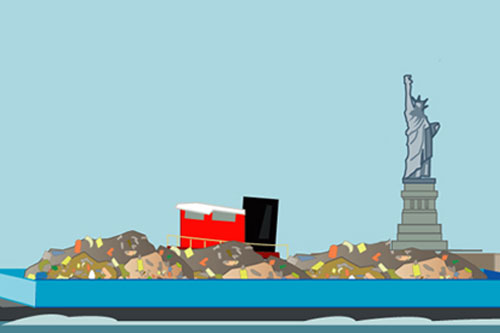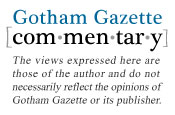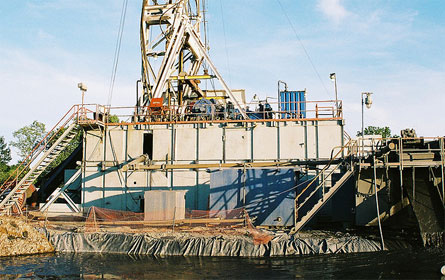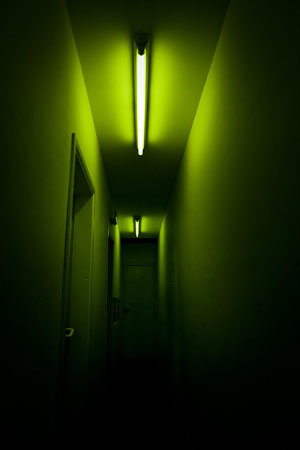Making 'Fair Share' Fairer

This is the second article in a series of commentaries Gotham Gazette will run between now and Election Day on the charter proposals appearing on the November ballot.
For decades, some low-income communities of color in New York have borne a disproportionate burden of polluting infrastructure. Communities such as Sunset Park, the South Bronx, East Williamsburg and Greenpoint are saddled with the bulk of the city's waste transfer stations, sewage treatment plants, bus depots and other facilities, both publicly and privately owned.
These communities are also the reluctant hosts of acres of brownfields and some of the busiest highways in the nation.

Clusters of pollution-spewing facilities have wreaked environmental havoc in these neighborhoods. They have been linked to disproportionate rates of severe health problems, such as off-the-charts childhood asthma rates and other cardio-pulmonary illnesses. As a result, organizations like UPROSE and El Puente in Brooklyn, Manhattan’s West Harlem-Morningside Heights Sanitation Coalition, and the South Bronx’s Nos Quedamos, The Point and Youth Ministries for Peace & Justice have spearheaded campaigns for environmental justice to challenge these noxious burdens and the ineffective public policies that put them there.
Until now, this struggle for environmental justice has been underscored by the failure of the City Charter policy called “fair share.”
In November, however, a new iteration of fair share will be on the ballot, and it is a proposal worthy of support. If approved, community districts overrun by private and public waste management and transportation facilities will begin to have a more complete picture of their environmental burdens.
A History of Unfairness
In 1989, neighborhood activists saw a glimmer of hope.
That year, the Charter Revision Commission added "fair share” criteria to the City Charter, making New York the first city in the nation to attempt to plan for the siting of city facilities in a more transparent and balanced manner.
Fair share encourages a more equitable distribution of city facilities. According to the charter, agencies are required to analyze a community district's share of city facilities, like sanitation garages or sewage treatment plants, before siting, expanding, closing or reducing a facility. The city also is required to provide annual notice of its facility plans to local community boards before making final decisions. The Department of City Planning also must publish the Atlas of City-owned Properties and its accompanying map, which identifies the location of all city facilities by address and block and lot number.
The charter allows community boards to hold hearings and -- along with borough presidents -- propose alternative sites before city agencies reach a final siting decision. This unprecedented level of transparency was supposed to give overburdened communities additional tools and a platform for both agencies and the public to strive for greater fairness.
These provisions are advisory, so they were not designed to tie an agency's hands. Rather, they were intended to help agencies plan better, increase transparency and allow affected communities a voice in the process.
However, fair share hasn't produced greater fairness or useful transparency.
Chief among fair share’s problems is that the Atlas of City-owned Properties and accompanying map only include city facilities. Of course, not only facilities owned and operated by the city have environmental impacts. The question presented to voters in November, as part of Question 2 on the City Charter, would begin to resolve this by including all public and private waste management and transportation facilities that overburden communities on the city map.
Polluting facilities operated by the state, public authorities and the private sector also undermine our local air quality. For example, some of the worst environmental impacts to local air quality and road infrastructure in East Williamsburg, Greenpoint and the South Bronx were generated by dozens of private waste transfer stations handling the city's solid waste. Presently these facilities are left off of the city atlas and map. This proposal would change that.
Under the current system, fair share rules require agency planners to look only at private waste management facilities within a 400-foot radius of a proposed "local" city facility or within a 10-block radius of a proposed "regional" city facility. As a result, any private or public facility beyond the 400-foot radius -- about half the length of an average city block -- does not appear on any map or analysis of a proposed local city facility. With city agency planners only looking within arbitrary areas with no scientific, medical or engineering basis, the entire pollution picture is left largely unexamined.
Fairness in a New Era
The limitations of the city’s fair share policy is even more apparent in the 2002 New York City Waterfront Revitalization Program. The program actually encourages the concentration and clustering of industrial and maritime activities in six areas called "Significant Maritime and Industrial Areas." These designations are found in communities of color like Sunset Park, Red Hook, Brooklyn Navy Yard, Newtown Creek, the South Bronx and Staten Island's North Shore.
Development applications in these districts must meet fewer review standards than those for other waterfront areas, thereby easing the siting and clustering of polluting infrastructure. Moreover, all of these areas are in storm surge zones. Given the concentration of industrial materials and uses in these districts, any significant storm surge could expose local residents and workers to hazardous materials and contaminate waters and adjacent land with dangerous chemicals, heavy metals or other hazardous substances.
These issues loom large for the city's environmental justice communities, many of which are waterfront communities whose residents have advocated for maritime and industrial area reform.
If our city map had adequately included all city, state, federal and private facilities in each community district, officials might have reconsidered clustering even more industry in these areas.
Closing the Loopholes
The NYC Environmental Justice Alliance, our members and some allies proposed multiple amendments to the 2010 Charter Revision Commission to address the loopholes in the city’s fair share review process.
For example, the alliance proposed that power plants and other public and private infrastructure be added to the atlas and accompanying map. Given the technological advances since 1989, we also proposed that the city include environmental and public health data for each community district -- data that is already collected by the departments of health and environmental protection, but not shared in one centralized, public and easily accessible location. Why not put all this relevant data in the atlas and map? (For more, please read our testimony on our website.)
In the end, the commission only agreed to mandate the inclusion of all state, federal and private facilities that handle solid waste and transportation in the city facilities map.
Our advocacy campaign was undermined by several factors. Some good government and social justice allies politically miscalculated that the mayor would re-empanel another commission after 2010, and therefore urged commissioners to “go slow/get it right." Still other allies -- and some elected officials -- were single-issue advocates concerned only with term limits or nonpartisan elections, and urged the commission to do nothing at all.
The commission itself repeatedly insisted it would not take on sweeping overhauls, given its short time frame.
Thankfully, several commissioners understood the value and fairness of what environmental justice activists and our allies proposed and advocated on our behalf.
While the 2010 commission left many proposals off the table, the expansion of the city's map reflects a much-needed first step in overhauling fair share. By voting yes on the map for facility siting question, New Yorkers will finally begin to see how truly overburdened some communities are -- and demand that something be done to correct this environmental injustice.
Eddie Bautista is the executive director of the NYC Environmental Justice Alliance.
Tackling Fracking

The Paterson administration saw it coming -- the economic collapse, state budget deficits growing to unprecedented proportions. "In a budget crisis we look for a pot of gold," said Susan Lerner, director of Common Cause NY.
The Paterson administration's pot, though, holds not gold, but natural gas.With New York home to large natural gas reserves, some project that tapping into the gas stored in the Marcellus Shale formations in the Southern Tier and around the New York City watershed could generate $1.5 billion in revenue for the state by 2015. The drilling could bring jobs to the state's impoverished towns and boost their economies.Gaining access to that gas would require a more powerful version of a method used to extract the gas by blasting millions of gallons of water into wells.
Despite the possible economic benefits, the plan to extract natural gas in New York has attracted opponents, who claim the environmental risks of the method that would be needed to extract gas from the Marcellus Shale far outweigh any financial and economic benefits. They fear the chemicals used in the hydrofracking process or the gas itself could pollute local water supplies. Hydrofracking is not new. Natural gas wells across the state have used the process--just not with the power and amount of water and chemicals that would be needed to extract in the Marcellus Shale.
While some legislators seek to halt the drilling, questions of if and how to extract the state's natural gas rest with the Department of Environmental Conservation. That agency could delay any action until a new administration takes over in January.
Getting the Gas Out
The key issue in the debate revolves around hydraulic fracturing, or hydrofracking, as it has become known. This process used to harvest natural gas from the earth involves blasting millions of gallons of high pressure water and chemicals into holes drilled in the ground. Companies like Chesapeake Energy Corp. were ready and willing to use the process to tap the state's gas.
Citing what they say is widespread environmental damage in the West, environmentalists and others say the chemicals could make the water dangerous to drink and produce toxic runoff .
In 2008 Gov. David Paterson signed a bill designed to streamline the permitting process to allow companies to drill. He also ordered the Department of Environmental Conservation to update its generic environmental impact statement, a document that would set the standards for hydrofracking across the state. Lerner said she would describe the normally environmentally conscious Paterson administration as "bullish" on fracking.
It wasn't long before environmentalists and city officials were decrying the dangers of drilling anywhere near the city's watershed. They charged the process could contaminate the water -- at best, necessitating expensive filtration systems, at worst making it undrinkable.
After a great outcry from the city and concerns expressed by the Obama administration, Chesapeake Energy Corp., the only gas company that owns a lease on land near the city's watershed, promised it would not drill on the land. While the promise reassured some, it did not mean drilling would never take place there. Other companies, not bound by Chesapeake's pledge, could acquire leases. Natural gas prices are currently low, and there are many other less controversial places to find it. That, of course, could change.
In April the department announced that the generic environmental impact statement would not apply to drilling in the New York City and Syracuse watersheds, and instead applications for wells in those areas would be considered on an individual basis. This means companies would have to undergo rigorous review for each well they proposed to drill, including public hearings. Opponents of fracking saw this as a reprieve for the watershed since getting individual permits could be costly and cumbersome. And the review process would give the opposition a chance to fight every well.
This, too, though did not mean there never would be drilling in the city's watershed, and it did not apply to drilling in other parts of the state.
The process of setting conditions for using hydrofracking in upstate New York continued. The Department of Environmental Conservation has issued its draft supplemental generic environmental impact statement, laying out the basics of the final statement for public review.
Meanwhile, the department continues to review public comments made about the draft generic environmental impact statement. The agency has said it will present a complete statement, but it is unclear when. The deadline has been changed from this fall to actually, there is no deadline, according to a spokesman.
Opponents of fracking are cautiously optimistic about this. They worry that the draft environmental impact statement does not fully protect surrounding water supplies and does not get New York the best deal for its natural gas. They do say that New York would require more of companies than a lot of states. Among other things, New York, unlike other states, would compel companies to reveal the chemicals they plan to pump into the ground during fracking.
A number of advocates hope the statement won't be issued until the new administration takes office.
"We are hopeful that if the decision is put off until a new administration can weigh in then reason will prevail," said Kate Sinding of the Natural Resources Defense Council.
Assembyman Robert Sweeney, chair of the Assembly’s Committee on Environmental Conservation, is sponsoring a bill that would place a moratorium on hydrofracking. "One of the reasons I want to pass the moratorium is that I want to give the incoming administration a chance to weigh in. I don't want to see a rush of permits in December and a new administration taking over in January and being stuck with it," he said.
The State Senate has already passed a moratorium.
The Promise
So what is the natural gas industry promising? At the most basic level, the state takes in fees for well permits according to the depth of the wells. Hydrofracking usually involves wells that range from 5,000 to 20,000 feet. The standard fee for a well of over 10,000 feet is $3,8000 plus $190 for each additional 500-feet of depth.
Brad Gill of the , a trade association founded in 1980, lists the financial rewards he sees for the state.
"Citizens benefit through lease revenues that are up to thousands of dollars an acre. Some have already earned a million dollars. I can just see the new John Deeres or kids going to college," he said.
If the land is owned by the county or state, the governmental entity benefits from lease payments. "Then there are the tax revenues," he said. "Right now the state makes over $10 million to $12 million a year in taxes on revenues created from drilling, but the general impact to the state could be over a billion dollars. There is also revenue to the state through jobs, new construction of buildings and people being hired.”
A study by Natural Resource Economics, Inc., projected that revenue from drilling could reach $1.5 billion by 2015.
Sweeney, though, said that money may not turn out to be the windfall some expect. "In Arkansas," he said, "the state has spent more money on repairing the roads damaged by the trucks and machinery required for the process than the state has made from taxes from drilling."
In the meantime, Sweeney said said he's still "hearing from people on both sides of the issue. But some people just see dollar signs, and I don't just mean the companies. I hear from Long Island residents who own property upstate and see opportunity in this."
The Promise of Jobs
Gill said that the state should not delay a decision forever. "People say to me 'the oil will be there.' Well it will, but jobs won't. They really won't," said Gill. "There are companies that are leaving and building out in Pennsylvania."
He cites , a company he says has moved "half their workforce" that was in New York out of state.
But some wonder how many and what kinds of jobs drilling operations would create.
"It is a boom-bust cycle," said Lerner. "Like the gold rush, the towns get a temporary economic boon." She says the workforce "is a group of roving energy professionals that live in motels and then move on. It is not the economic boon to these places it is thought to be."
Sweeney agrees. "They call them man camps in Colorado. They are surrounded by barbed wire. They keep the workers fenced in to stop problems between them and the locals," he said.
Gill says some traveling professionals are hired, but drilling does create significant numbers of local jobs. "We have contracts with some highly skilled workers, but we also create local jobs. We have a company with 70 percent local and 30 percent out of town," he said.
Battle for Hearts and Minds
Both sides in the dispute are fighting hard to win over public opinion -- and the state government. For the natural gas companies, Lerner said that means spending millions of dollars to counter the public outcry.
In June, Common Cause NY study that looked at how much money the natural gas industry is pouring into its campaign to get approval for hydrofracking. A similar Common Cause study in Pennsylvania had showed a striking relationship between campaign donations from the natural gas industry and well approvals. The New York study found the natural gas industry is spending its money in a different way here.
Since 2005 the companies have spent $2 million on lobbying -- most of money in the last two years. Lerner said that a good portion of recent expenditures have gone to buy advertising as the natural gas companies try to win over voters with the promise of financial benefits. Lerner said that, in some ways, those buys could be considered campaign expenditures, because the ads are airing during the campaign season.
"There has not been as much spent on campaign contributions -- not the level spent in Pennsylvania -- but the advertising is going on during the election season, and it may be a bleed-over," said Lerner.
Gill disputes that his industry has spent much on lobbying or advertising. In fact, he said, he thinks the anti-fracking movement is winning the battle for hearts and minds. "I think we are losing the battle for public opinion. I hate to admit it, but we are. I've always said emotion will win out over science and reason, much to my chagrin."
One indication of where public sentiment lies could be the fact that the Working Families Party, a pro-labor group, has created a campaign to support a moratorium on fracking. "I think that on one level you think, this is an environmental issue, so why is the WFP getting involved," said WFP spokesman Dan Levitan. “The hydrofracking fight is about corporate power vs. democratic power. It is about how far corporate power goes. We heard from our own members, who asked us to get into this."
And Levitan points out that the issue matters to people across the state. "There are few issues that traverse the great expanse of this state, but everyone drinks water, so this does."
We Wait
So now the natural gas industry and opponents of fracking wait for the Department of Environmental Conservation to provide its final draft generic environmental impact statement. In the meantime, the Assembly could convene as expected in November and pass the moratorium already passed by the Senate. Gill said he has been discussing the measure with the Assembly to point out what he calls flaws in the Senate bill. For example, he said, as currently written, the bill would ban shallow drilling that does not involve fracking, which has generally been accepted as safer than hydrofracking and has been going on in the state for decades.
"The way the Senate bill is written it would decimate the existing industry," said Gill. "More jobs lost -- but I’m sure they didn’t intend it that way." When asked how he would like to see things progress, Gill said although he sees the draft generic environmental impact statement as "a heavy hammer over the industry" and "a hard pill to swallow," he would like to see it enacted this fall.
In that case, "absent any litigation, drilling would begin this spring," Gill said. But he isn’t holding his breath.
The possible new state bosses have weighed in to some extent. Anti-fracking advocates are concerned that Democratic gubernatorial candidate Andrew Cuomo is amenable to the natural gas industry and targeted him with petitions and protests. Gill said he has high hopes for Cuomo because he understands both "the safety concerns and the impact it would have on the economy of western New York."
It is expected his opponent, Carl Paladino, would be in favor of fewer restrictions, although his campaign did not respond to calls for comment.
In a written response, the campaign of the Democratic candidate for attorney general, State Sen. Eric Schneiderman, said, "Neither the state nor the federal government has determined that hydrofracking is a safe practice, and Eric will sue to make sure that no drilling takes place until it is." The campaign of Republican candidate for attorney general, Staten Island District Attorney Daniel Donovan, did not respond to requests for comment.
Stated Meeting: Green Light!

Shining a light on electricity usage, the City Council approved a package of legislation Wednesday that aims to increase efficiency, including a bill requiring commercial properties to use light sensors.
The bills all update the city's building code to incorporate and emphasize green building practices.
In addition, the council approved legislation to siphon off spaces in garages for shared vehicles, like Zipcar.
Green lights
The product of a green code task force convened by Council Speaker Christine Quinn and the Bloomberg administration, the legislative package is one of many steps to come that will force city buildings to use less energy, Quinn said.
"This package of legislation is turning the lights off on wasteful lighting," said Quinn.
One piece of the measures (Intro 266) would require commercial properties install sensors in small office spaces that would detect whether the room was occupied. The sensor would subsequently shut off the lights if it were vacant for more than 30 minutes. The bill does not take effect until January.
Office spaces with less than 200 square feet, break rooms and classrooms would all have to have sensors under the bill.
The council also approved legislation (Intros 262-A and 277-A) to allow occupant sensors and photosensors, which measure the amount of natural light in the area, in residential buildings, such as hallways or stairways, and in public areas of commercial buildings, like entrances. It would allow building owners to install energy efficient lighting, like motion sensors, in these areas as long as it would not present a safety hazard.

The final two bills modify the building code to force new projects to consider energy efficient standards (Intro 267-A) and revise the minimum lighting standards to use foot-candles instead of watts. Foot-candles measure luminosity, while the watt is a measure of power.
Car Share Spaces
The council wants to save a space for car shares.
It unanimously passed legislation to set aside space for car share programs in garages across the city to make the service more accessible to their growing membership.
A third of the total car-sharing members nationwide are within the five boroughs, according to the council. That membership increased by 50 percent in 2008 to 279,174 people.
The legislation approved Wednesday would not only ensure spaces are available in garages but it would also, for the first time, regulate where these vehicles are parked. It prohibits parking on residential streets, council officials said.
The bill allows car share vehicles to park in up to 40 percent of spaces in public garages, 20 percent in medium to high density residential garages and 10 percent in a lower density residential districts as well as commercial, community or manufacturing garages.




